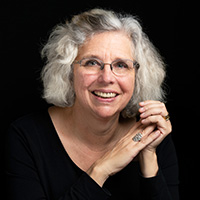
Epidermolysis bullosa (EB): This genetic skin condition is sometimes called butterfly disease, because the skin of affected people is so delicate. So when a client with EB, plus fibromyalgia, plus blood thinner use asks for “very deep work,” what do we do?
Resources:
About EB | debra of America (no date). Available at: www.debra.org/about-eb?gclid=Cj0KCQjwvO2IBhCzARIsALw3ASozFxUG40gTcg2rI5rwJWdlzUkB7_OO0-9TUcTwReIb5DI22S3TBcQaAkNIEALw_wcB
"Epidermolysis Bullosa" (no date) NORD (National Organization for Rare Disorders). Available at: https://rarediseases.org/rare-diseases/epidermolysis-bullosa/
"Epidermolysis Bullosa: Background, Pathophysiology, Etiology" (2021a). Available at: https://emedicine.medscape.com/article/1062939-overview
What is EB? (no date) EB Research Partnership. Available at: https://www.ebresearch.org/what-is-eb.html


This podcast sponsored by:
About Anatomy Trains:
Anatomy Trains is a global leader in online anatomy education and also provides in-classroom certification programs forstructuralintegration in the US, Canada, Australia, Europe, Japan, and China, as well as fresh-tissue cadaverdissectionlabs and weekend courses. The work of Anatomy Trains originated with founder Tom Myers, who mapped the human body into 13 myofascial meridians in his original book, currently in itsfourthedition and translated into 12 languages. The principles of Anatomy Trains are used by osteopaths,physicaltherapists,bodyworkers,massagetherapists,personaltrainers,yoga,Pilates,Gyrotonics,and other body-minded manual therapists and movement professionals. Anatomy Trains inspires these practitioners to work with holistic anatomy in treating system-wide patterns to provide improved client outcomes in terms of structure and function.
Website:anatomytrains.com
Email:info@anatomytrains.com
Facebook:facebook.com/AnatomyTrains
Instagram: instagram.com/anatomytrainsofficial
0:00:00.0 Speaker 1: Ruth Werner's best-selling book, A Massage Therapist's Guide to Pathology, is a highly-regarded comprehensive resource that sets the standard for pathology education. Written for massage therapy students and practitioners, this ground-breaking resource serves up a comprehensive review of the pathophysiology signs, symptoms, and treatment of more than 500 diseases and disorders. Learn more at booksofdiscovery.com.
0:00:33.2 Speaker 2: Anatomy Trains is delighted to announce a brand new dissection live stream specialty class in September 18th. Lumbopelvic stability, a one-day layered dissection with Anatomy Trains' author, Tom Myers and master dissector, Todd Garcia. The early bird price of $150 is held until September 10th. After September 10th, the price is $250. Come see the body's actual core for yourself. This course will be provided over Zoom webinar with multiple camera views, live chat and Q&A. Visit anatomytrains.com to sign up.
[music]
0:01:15.4 Ruth Werner: Hi, and welcome to "I Have A Client Who... " Pathology conversations with Ruth Werner, the podcast where I will discuss your real life stories about clients with conditions that are perplexing or confusing. I am Ruth Werner, author of A Massage Therapist's Guide to Pathology, and I have spent decades studying, writing about and teaching about where massage therapy intersects with diseases and conditions that might limit our client's health. We almost always have something good to offer even with our most challenged clients, but we need to figure out a way to do that safely, effectively, and within our scope of practice. And sometimes, as we have all learned, that is harder than it looks.
0:02:00.3 RW: Today's episode involves a client with a complicated and somewhat contradictory set of conditions and circumstances that I am eager to share with you. This is kind of a weird one. You're ready? Here's what I got when this massage therapist contacted me through my website. Good morning, I have been contacted by a client who has epidermolysis bullosa hereditaria, also fibromyalgia, and is on thinners for previous clot issues. She works 80 or more hours a week at a computer and has neck and shoulder stiffness. This doesn't really track with most of my fibro clients, because they would not be able to work that long, but she was requesting only upper body work and we started supine. I noticed no visible lesions on her skin, she had stated that she had had massage therapy before and that it was very deep.
0:02:56.9 RW: However, I believed that deep pressure was contraindicated due to both the skin condition and the fibro. She told me not to be alarmed when her skin would turn very red and that she would let me know if it was too much friction. I used a fairly slippery lavender based cream, but did not notice much redness as I worked on her. However, I was purposefully trying to be a light touch and mainly just try to calm down her nervous system a bit. I've been trying to find some information on massage therapy for epidermolysis bullosa, but I have been unsuccessful. I thought I'd reach out to you to see what you think.
0:03:35.6 RW: Okay, I'm gonna guess that a lot of listeners are unfamiliar with epidermolysis bullosa, which is sometimes called Butterfly disease. So, let's take a closer look. Epidermolysis bullosa, which I will sometimes call EB, 'cause it's way easier to say, is a disorder of the skin. Now, you can get that from the first word epidermolysis, which suggests lysis or loosening of the epidermis. And bullosa means blisters or large vesicles. It is rare affecting somewhere between 25,000-50,000 people in this country. Males and females are affected equally, and there's no particular racial or ethnic distribution, everyone is equally at risk. It's a genetic disease. It's a situation in which genetic anomalies cause defects in the way layers of the skin attach to each other, and this allows the formation of large vesicles or blisters, which can rip, and this is why it is sometimes called Butterfly disease.
0:04:39.6 RW: Babies with epidermolysis bullosa are incredibly delicate. These rips and tears in the skin can become infected, which can lead to sepsis and amputation. EB affects the surface of the skin, but some people are also affected in their mucous membranes and the esophagus. It's not surprising that our contributor couldn't find anything about massage therapy for people with epidermolysis bullosa, seems like EB is a walking definition of a contraindication, doesn't it? Well, listen on. So there are four subtypes of epidermolysis bullosa, which are classified by the layers of skin that are affected. Not that you would ever need to know this, but for the sake of thoroughness here they are, dystrophic epidermolysis bullosa is a type that affects the skin and some internal organs, especially the esophagus. It can cause scarring and webbing and narrowing of the esophagus, so that some patients end up needing a feeding tube.
0:05:43.2 RW: Epidermolysis bullosa simplex is a situation where blisters form wherever there's friction and rubbing, so the hands and the feet are affected the most. Junctional epidermolysis bullosa, this one is severe and often leads to death in infancy or early childhood due to massive infection, malnutrition, dehydration, and problems with the airway. And Kindler Syndrome, which is thankfully the rarest type, involves weak junctions between all layers of the skin. The client in today's story says, she has epidermolysis bullosa hereditaria. That just means, she was born with it as opposed to epidermolysis bullosa acquisita, which is an acquired form related to an autoimmune attack on a certain kind of collagen. EB is usually an autosomal recessive disorder, which means that a person must inherit a collection of abnormal genes for these traits in the skin from both parents.
0:06:41.8 RW: We don't know which subtype this client has, but that's probably not the most important issue. This condition varies in severity from being a mild inconvenience to being a cause of childhood mortality. And I'm here to say, Do yourself a favor and don't look up pictures of EB. I can manage photographs of adults with various disorders, because you know that to get their picture taken, they were getting appropriate medical care, but it's just a lot harder when we see these kinds of problems in children. EB as yet has no medical treatment, although some genetic therapies are under investigation, but for babies born with this condition, treating it is mainly a matter of controlling the risks for infection and other complications. So this means using extra padding at any possible points of friction, avoiding any adhesives and bandages and monitoring blisters, which may need to be drained because they don't usually heal on their own.
0:07:43.6 RW: Okay, so that's all what's in the literature for relatively severe cases of EB, but our client shows us that it is possible to have this condition and not have it be disabling. In addition, she reports having fibromyalgia and using blood thinners and having a very demanding job that requires more than 10 hours a day at a computer. It's not surprising she would have stiffness and pain in her shoulders, neck and back, is it? I completely resonate with this massage therapist's reluctance to go directly to the very deep pressure that this client asked for. After all, we have three issues here that could suggest that that's not a great idea. We have a genetic condition of the skin that suggests any kind of friction could cause damage. We have fibromyalgia, which usually precludes super intense work, and we have some kind of unstated history with blood clots that requires that this client use blood thinners.
0:08:41.2 RW: So, just think for a moment, if this client came to see you, what would you do in this situation? Would you work with her at all? How deeply would you work. If she asks for deeper pressure than you feel is in her best interest, how would you respond? Let's just ponder that for a moment. And here is what our contributor did. I started with her supine, I did effleurage and gentle Petrissage on scalenes, traps and deltoids and some very gentle trigger point work on her sternocleidomastoid and scalenes, followed by some gentle range of motion. I moved to her arms and continued with effleurage and Petrissage gently with shoulder range of motion, again, watching her skin very closely. I had to turn her to prone position to address traps, rhomboids and so on with some myofascial release, effleurage and Petrissage. During the entire session, not once did I notice any skin issues, which did not match up with what I thought I understood of the disease.
0:09:48.0 RW: I followed up with her the next day, and she stated that it was indeed relaxing, but she did not feel like it addressed any of her pain, and she wanted deeper massage the next time. Fantastic. I think this massage therapist did an amazing job of balancing all the contraindications that she recognized with what her skillset allowed for some reduction of stress, and she followed up the next day, which is so important. The client was not completely satisfied, but you know what? That's okay. Because she's coming back, and that means something passed between them that is functional. My suggestion is that the massage therapist's extra care for this person's safety and well-being created a setting that she wants more of, and who wouldn't? I suggest that this massage therapist go ahead and try some more pressure with the next appointment, but to progress incrementally, monitoring changes as they go.
0:10:51.1 RW: I'd also like to see what this client does to help manage her fibro, so that the massage can augment that effort, and I'm curious about her clotting disorder and whether she has any side effects from her medications, because that could also play into some clinical decisions. But all things considered, I give this massage therapist an A plus, plus plus, plus my thanks for contributing her great I have a client who story to our podcast.
0:11:21.0 RW: Hey everybody, thanks for listening to "I Have A Client Who... " Pathology conversations with Ruth Werner. Remember, you can send me your I Have A Client Who stories to, ihaveaclientwho@abmp.com. That's ihaveaclientwho, all one word, all lowercase @abmp.com. I can't wait to see what you send me and I'll see you next time.
[music]